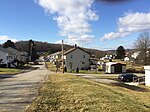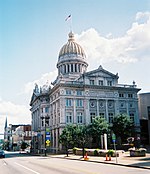Westmoreland Mall

Westmoreland Mall is a two-level, enclosed super-regional shopping and casino complex in the municipality of Hempfield Township, Pennsylvania, southeast of Pittsburgh, and owned and operated by CBL Properties. It was completed in 1977 and was extensively renovated and expanded in 1993–1994. The mall features retailers JCPenney, Macy's, and Macy's Home, in addition to Live! Casino Pittsburgh. It contains 1,287,620 square feet (119,624 m2) of retail space on 103 acres (0.4 km2) and over 170 retailers, making it the second-largest shopping complex in Western Pennsylvania in terms of square footage and the largest mall between Pittsburgh and Lancaster.Surrounding the mall are over 25 retailers and dining establishments, including the Westmoreland Crossing strip shopping center, which opened in 1978 and features a 15-screen AMC Theatres complex, Dick's Sporting Goods, Levin Furniture, Michaels Arts and Crafts, Planet Fitness and T.J. Maxx. A variety of restaurants and outparcels completes the mall complex. It is located on the eastern side of the Greater Pittsburgh region on the heavily traveled U.S. Route 30 corridor. Adjacent to Westmoreland Mall, many big box retailers and restaurants can be found along the U.S. Route 30 and Donohoe Road retail area, which is the biggest concentration of retailers and other commercial businesses between Monroeville and Altoona.
Excerpt from the Wikipedia article Westmoreland Mall (License: CC BY-SA 3.0, Authors, Images).Westmoreland Mall
Old State Route 30,
Geographical coordinates (GPS) Address External links Nearby Places Show on map
Geographical coordinates (GPS)
| Latitude | Longitude |
|---|---|
| N 40.301 ° | E -79.508 ° |
Address
Westmoreland Mall
Old State Route 30 5256
15601
Pennsylvania, United States
Open on Google Maps









